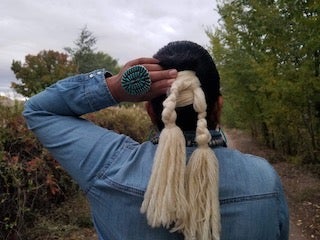 As a Navajo Nurse-Midwife, when I attend seminars and conferences I can count on being asked a particular question in each and every setting, and it sounds something like this:
As a Navajo Nurse-Midwife, when I attend seminars and conferences I can count on being asked a particular question in each and every setting, and it sounds something like this:
“What traditional birthing practices do Native women have?” It almost feels like they expect me to reach into a pouch and pull out a handful of herbs or a vial of potions, or perhaps utter some incantation in my tribal language.
There has been a great deal of high-profile media coverage about the maternal health and death crises for African American women in recent years. But if you were to do a literature review about the barriers Native American women experience in accessing health care, you would find outdated information and many articles written by non-native researchers focusing on our high rates of STDs or our traditional healing practices. There is no current research dedicated to understanding the lived experiences that Native American women have to demonstrate what it’s like for them to access care through the colonial settler medical system.
In fact, it’s probably not hard to believe, but for the first time in history, on February 12, 2019, a congressional briefing was held on Native American Maternal health in Washington D.C. Indigenous women leaders working to address maternal health disparities in the areas of missing and murdered indigenous women, reproductive rights, and access to healthcare participated. They spoke as key advisors to share their perspectives. After the hearing, it was clear that despite policy changes and medical technological advances over the past decade, the needs of Native American women still aren’t being adequately addressed.
This begs the question of “why.” Why isn’t there research dedicated to explaining Native American’s lived experiences around birth, motherhood, and all around reproductive choices?
As someone who spends a lot of time traveling in White America, I often encounter deep rooted stereotypes of who people think we are as Native Americans. They often want me to step aside and show them where the “real” Indigenous midwives are, so they can snap a picture with a “real Indigenous midwife.”
The people who meet me would rather see something exotic, colorful, mystical. They want chants and feathers when we need reproductive justice and empowered advocacy.
Understanding maternal health disparities for Native American women goes beyond the mystical. There is a profoundly deep problem with our health care system. A recent study by the CDC reported that “non-Hispanic American Indian/Alaska Native (AI/AN) women experienced higher Pregnancy Related Mortality Ratios (40.8 and 29.7, respectively) than all other racial/ethnic populations https://www.cdc.gov/media/releases/2019/p0905-racial-ethnic-disparities-pregnancy-deaths.html. However, I believe before we can even begin to unpack all the factors leading to the Native American maternal death rates, we need to have an opportunity discuss the full-on history of discrimination, racism, exploitation, capitalism, and warfare that have impacted the reproductive choices of Native American women. For example, a manual recently surfaced called “Indian Babies, How to Keep Them Well.” The 1916 pamphlet described how the government and the church would assimilate Indian children from childbirth on and do away with tribal systems, essentially by stripping away their culture, language, and identity.
The historical timeline of violations around our reproductive rights can be mapped out by federal Indian Health Policies and pharmaceutical advancements over the years. From forced sterilizations in the 1970s, to fighting for access to Plan B and abortion care within government systems like the Indian Health Services. Native American women have struggled for recognition and empowerment over their reproductive choices for generations.
As more Native American women step into their power and demand for better birthing and women’s health options in their communities, more and more invisible barriers are unveiled. Right now, the only option that federally recognized Native American women have to access women’s health care is through Indian Health Services. However, this comes with conditions. You must be living in your service area. Referrals for care outside of this system must be generated from within Indian Health Services. If your living in a remote and rural location, you might still have to drive 1-hr or more for care. A recent study that focused on the impact of travel on maternal and infant health outcomes found that women who have to travel 30 miles for hospital-based care also had fewer prenatal visits and gave birth to infants with lower birth weights and lower gestational ages (Hamlin, 2018).
States are just now starting to implement tools to measure maternal health workforce, perinatal taskforces, but where does that leave Native American women? Our health statistics don’t tell the entire story. It is absolutely vital we evaluate how these systems are working or not working for Native American communities, because addressing the maternal health crises in Indian country isn’t just about returning birth back to communities and reviving our traditional birthing practices.
It’s about acknowledging that the missing murdered indigenous women’s movement is part of those crises.
It’s acknowledging that having access to reproductive services like abortion is also part of the equation.
It’s acknowledging that lack of funding for community-centered healing solutions is also a factor.
It’s time to demand for a liberated reproductive justice movement that centers Native American experiences and responds to our unique history. Anything less is a too little, too late.
Nicolle Gonzales, a 2019 Healthy Communities Fellow, is a certified Nurse-Midwife and founder of the Changing Woman Initiative, a New Mexico-based organization to advance indigenous women’s reproductive rights. She focuses on birth equity for Native American women and has served as the founding board president and vice board president of two new birth centers in New Mexico. She is a writer and an advocate for indigenous birth, midwifery, reproductive justice, and indigenous feminism

